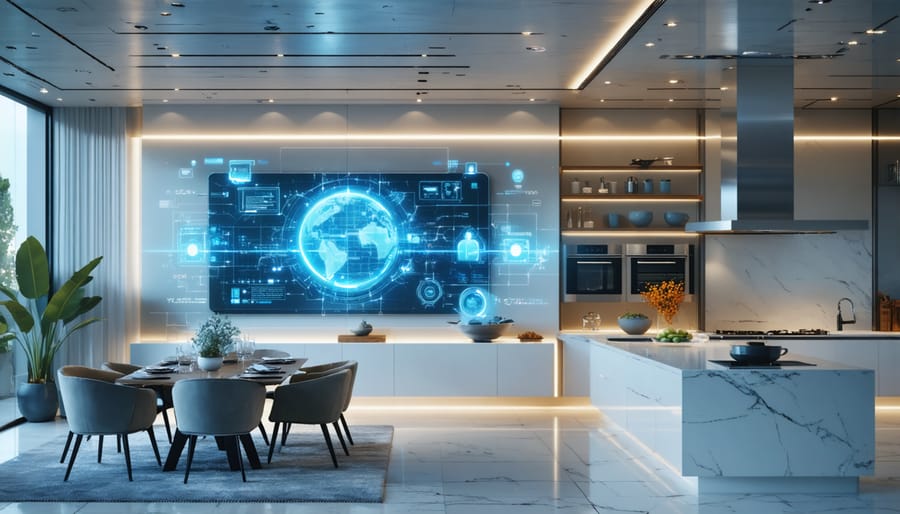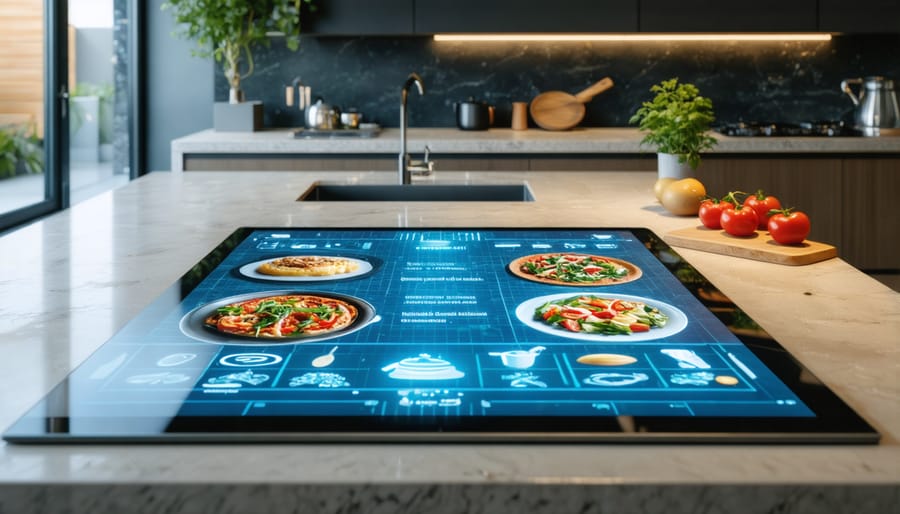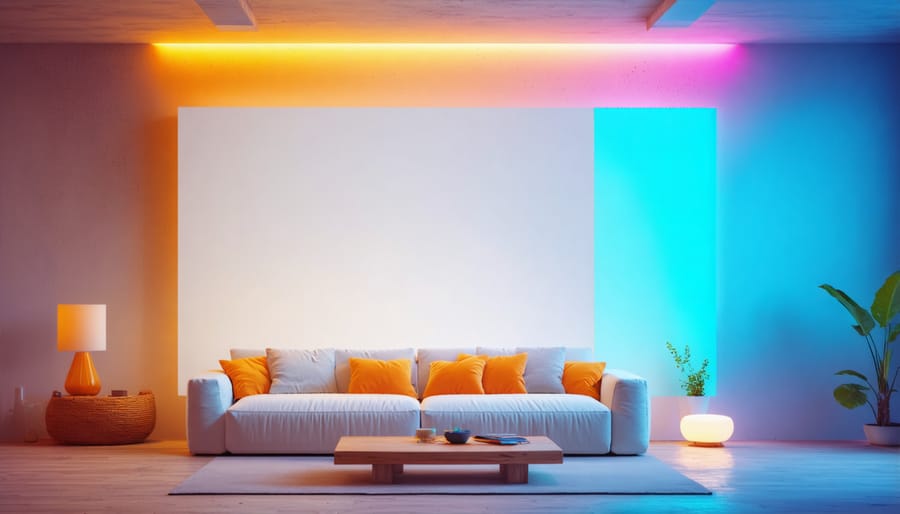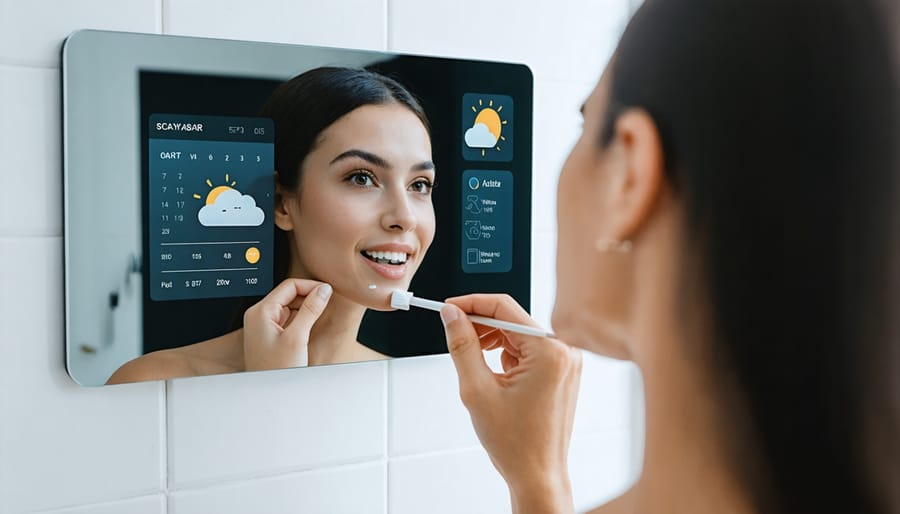
Smart Surfaces Transform Your Home Into a Living Space That Responds to You
Transform your living space into an intelligent ecosystem with smart systems that redefine home design. Today’s smart interiors merge cutting-edge technology with thoughtful design, creating spaces that anticipate needs, enhance comfort, and streamline daily routines. From voice-activated lighting systems to temperature-sensing walls and interactive surfaces that double as control centers, smart interiors represent the perfect fusion of functionality and innovation. These intelligent environments don’t just respond to commands – they learn, adapt, and evolve with your lifestyle, making your home more efficient, sustainable, and enjoyable. Whether you’re renovating a single room or designing an entire smart home, the technology exists to create spaces that work in harmony with your daily life, all while maintaining the aesthetic appeal and comfort you desire.
What Makes a Surface ‘Smart’?
Touch-Sensitive Materials
Touch-sensitive materials are revolutionizing how we interact with our living spaces, transforming ordinary surfaces into intuitive control interfaces. These smart surfaces typically use conductive materials like indium tin oxide (ITO) or carbon nanotubes embedded within traditional building materials. When combined with pressure-sensitive sensors or capacitive touch technology, these materials can detect and respond to human touch.
Popular options include electroactive polymers that change properties when touched, piezoelectric materials that generate electrical charges under pressure, and smart fabrics woven with conductive threads. These materials can be incorporated into wallpapers, countertops, furniture surfaces, and even floor tiles.
The latest innovations include self-healing touch surfaces that maintain functionality even after minor damage, and multi-touch materials that can recognize multiple contact points simultaneously. Some manufacturers now offer retrofit solutions that can transform existing surfaces into touch-sensitive interfaces using special adhesive overlays or paint.
For DIY enthusiasts, conductive paint and programmable touch sensors are available to create custom interactive surfaces, though professional installation is recommended for whole-room solutions.
Embedded Technology
At the heart of smart interiors lies a sophisticated network of embedded technologies that work seamlessly together. Motion sensors detect movement and occupancy, while ambient light sensors adjust illumination based on natural light levels. Temperature and humidity sensors maintain optimal comfort levels throughout your space. These sensors connect to central processors, which act as the “brain” of your smart interior system.
The integration of smart flooring technology has revolutionized how we interact with our living spaces, using pressure-sensitive sensors to track movement and enhance safety. Most modern smart interior systems utilize Wi-Fi, Bluetooth, or Zigbee protocols to ensure reliable connectivity between devices and your home automation hub.
Voice recognition modules and touch-sensitive surfaces are becoming increasingly common, allowing for intuitive control of lighting, temperature, and entertainment systems. Many of these components are designed to be energy-efficient and can be easily upgraded as technology advances, making them a practical investment for forward-thinking homeowners. The key is choosing components that work together harmoniously while meeting your specific needs and lifestyle requirements.
Smart Surfaces in Action
Interactive Countertops
Interactive countertops are revolutionizing how we interact with our kitchen spaces, joining the growing trend of smart surfaces in modern homes. These innovative surfaces combine touch-sensitive displays with practical functionality, transforming ordinary countertops into intuitive cooking assistants.
Imagine following a recipe without reaching for your phone or tablet – the countertop itself displays step-by-step instructions, ingredient measurements, and cooking times right where you’re working. Built-in temperature sensors alert you to hot spots and can even help maintain precise temperatures for tasks like chocolate tempering or dough proofing.
These smart surfaces can recognize items placed on them, automatically adjusting to create safe hot and cool zones. Place a hot pan down, and the surrounding area instantly becomes a protected zone, while other sections remain active for food prep. Some models feature wireless charging zones for your devices and can sync with your smart home system to control lighting and ventilation.
For busy families, these countertops include practical features like grocery list creation, meal planning, and even direct ordering from local stores. The surfaces are designed with durability in mind, featuring scratch-resistant, easy-to-clean materials that stand up to daily kitchen use while maintaining their smart functionality.
With customizable displays and intuitive controls, these countertops make cooking more efficient and enjoyable for both amateur cooks and seasoned chefs.

Responsive Walls
Gone are the days of static, unchanging walls. Today’s responsive walls transform your living space with a simple tap or voice command. These intelligent surfaces can shift colors to match your mood, display important information like weather updates and calendar events, or serve as control centers for your entire home automation system.
Imagine walking into your living room and having your walls automatically adjust their hue to complement the natural light, or displaying your favorite artwork in rotation throughout the day. These smart walls use advanced display technologies, including micro-LED panels and color-changing materials, to create dynamic environments that adapt to your needs and preferences.
The practical applications are endless. In home offices, walls can transform into interactive workspaces with digital whiteboards and video conferencing capabilities. In kitchens, they can display recipes and cooking tutorials. For entertainment, they become immersive screens for gaming or movie nights.
Control options range from smartphone apps to voice commands and gesture recognition. Many systems integrate seamlessly with existing smart home platforms, allowing you to adjust lighting, temperature, and security settings directly from your walls.
While this technology represents a significant investment, prices are becoming more accessible as the technology evolves. Installation can be as simple as applying special panels over existing walls or as comprehensive as a full wall replacement with integrated smart systems.

Smart Mirrors
Smart mirrors are revolutionizing our daily routines by transforming ordinary reflective surfaces into interactive digital displays. These sophisticated devices combine traditional mirror functionality with smart technology to create an engaging and practical interface for your home or business.
Imagine checking the weather forecast, scanning news headlines, or reviewing your calendar while brushing your teeth. Smart mirrors make this possible by incorporating LED displays behind partially reflective glass, creating a seamless blend of mirror and screen. Many models feature touch-sensitive surfaces or voice control, allowing you to interact with the interface naturally.
One of the most exciting applications is virtual try-on technology, particularly popular in retail settings and high-end home dressing rooms. Users can virtually sample different clothing items, makeup looks, or hairstyles without physical changes. For home use, smart mirrors can display fitness metrics, medication reminders, or even video calls with family members.
Installation options range from ready-made solutions to DIY projects for tech enthusiasts. Most smart mirrors connect to your home’s Wi-Fi network and can integrate with other smart home devices, creating a cohesive ecosystem. Popular features include customizable widgets, morning routines that display your daily schedule, and even built-in motion sensors that activate only when someone approaches.
When selecting a smart mirror, consider factors like display size, resolution, and compatibility with your existing smart home setup. While the initial investment might be higher than traditional mirrors, the added functionality and convenience make them an increasingly popular choice for modern interiors.

Installation and Integration
DIY vs Professional Installation
When it comes to implementing smart interior solutions, you’ll need to choose between DIY installation and professional services. While DIY can save money and offer a sense of accomplishment, professional installation ensures optimal performance and reliability.
DIY installation works best for simple, plug-and-play devices like smart lighting, automated blinds, or standalone interactive displays. These typically come with user-friendly apps and clear installation guides. You’ll need basic tools, a stable Wi-Fi connection, and some patience. The key advantage is flexibility – you can work at your own pace and modify the setup as needed.
However, more complex systems like integrated wall panels, smart mirrors, or whole-home automation often require professional expertise. Professionals bring specialized knowledge about electrical systems, network configuration, and proper calibration. They can ensure seamless integration with existing home systems and provide valuable guidance on optimal placement and usage.
Cost considerations vary significantly. While DIY installation mainly involves product costs, professional installation includes labor charges but often comes with warranties and ongoing support. For businesses or high-end residential projects, professional installation is typically the safer choice.
Before deciding, assess your technical comfort level, project complexity, and long-term maintenance needs. Many manufacturers offer hybrid solutions where you can DIY basic features while calling professionals for advanced integrations or troubleshooting.
Connection with Smart Home Systems
Integrating smart surfaces with your existing home automation system creates a seamless, intuitive living environment. Modern smart surfaces are designed to work harmoniously with popular platforms like Google Home, Amazon Alexa, and Apple HomeKit, making it easier than ever to incorporate these innovative elements into your space.
To begin the integration process, ensure your smart surfaces are compatible with your current smart home automation features. Most contemporary smart surfaces come with built-in WiFi or Bluetooth connectivity, allowing them to communicate directly with your home’s central hub.
Creating automated routines is where the magic happens. For example, you can program your smart walls to adjust their opacity when your smart blinds open, or have your interactive countertops display your daily schedule when your smart coffee maker starts brewing in the morning. The key is to think about how these surfaces can enhance your existing automation sequences.
For the best results, consider working with a home automation specialist during installation. They can help ensure proper connectivity and teach you how to maximize the potential of your integrated system. Remember to regularly update your smart surface firmware to maintain compatibility with your home automation platform and access new features as they become available.
Cost and Value Considerations
Investing in smart interior technology requires careful consideration of both upfront costs and long-term benefits. Initial expenses typically range from $500 for basic smart lighting systems to $10,000 or more for comprehensive home automation solutions. However, these investments often pay dividends through reduced energy costs, increased property value, and enhanced living comfort.
Entry-level smart features, such as automated blinds and intelligent thermostats, usually cost between $200-600 per room. Mid-range implementations, including interactive walls and smart mirrors, can range from $1,000-3,000 per feature. For those seeking premium solutions, fully integrated smart surfaces and responsive environments might require investments of $5,000-15,000 or more.
The good news is that smart interior features typically deliver measurable returns. Energy savings from intelligent lighting and climate control systems often range from 20-30% annually. Smart windows and automated shading can reduce heating and cooling costs by up to 25%. These savings can help offset initial installation costs within 3-5 years.
Property value benefits are equally compelling. Real estate experts report that homes with smart interior features command 3-7% higher selling prices than comparable traditional properties. Commercial spaces with smart implementations often see increased tenant satisfaction and can command premium rental rates.
For budget-conscious homeowners, a phased implementation approach can make smart interior upgrades more manageable. Starting with core features like smart lighting or climate control allows for gradual expansion while spreading costs over time. Many manufacturers also offer financing options and professional installation packages that include maintenance plans.
When evaluating costs, consider factors beyond purchase price, such as installation requirements, ongoing maintenance, potential energy savings, and system compatibility. While premium solutions offer more features, mid-range options often provide the best balance of functionality and value for most households. Remember that proper installation and regular maintenance are crucial for maximizing your investment’s longevity and performance.
As we look to the future of interior design, smart surfaces stand at the forefront of a revolutionary change in how we interact with our living and working spaces. These innovative technologies are transforming ordinary walls, countertops, and furniture into responsive, intelligent interfaces that adapt to our needs and enhance our daily lives.
The potential impact of smart surfaces extends far beyond mere convenience. From energy-efficient homes that automatically adjust lighting and temperature to commercial spaces that provide seamless interactive experiences, the possibilities are boundless. We’re seeing increased adoption of these technologies in healthcare facilities, educational institutions, and retail environments, proving their versatility and value across different sectors.
Looking ahead, we can expect even more exciting developments. Advances in materials science and artificial intelligence will likely bring us self-cleaning surfaces, more sophisticated touch recognition, and even better integration with our smart home ecosystems. Prices are expected to become more accessible as manufacturing processes improve and market competition increases.
For homeowners and designers considering smart surface implementation, now is an excellent time to start planning. While the technology continues to evolve, the fundamental benefits – enhanced functionality, improved energy efficiency, and increased property value – are already well-established. By thoughtfully incorporating these solutions into your space today, you’ll be well-positioned to adapt and upgrade as new innovations emerge in this rapidly advancing field.
